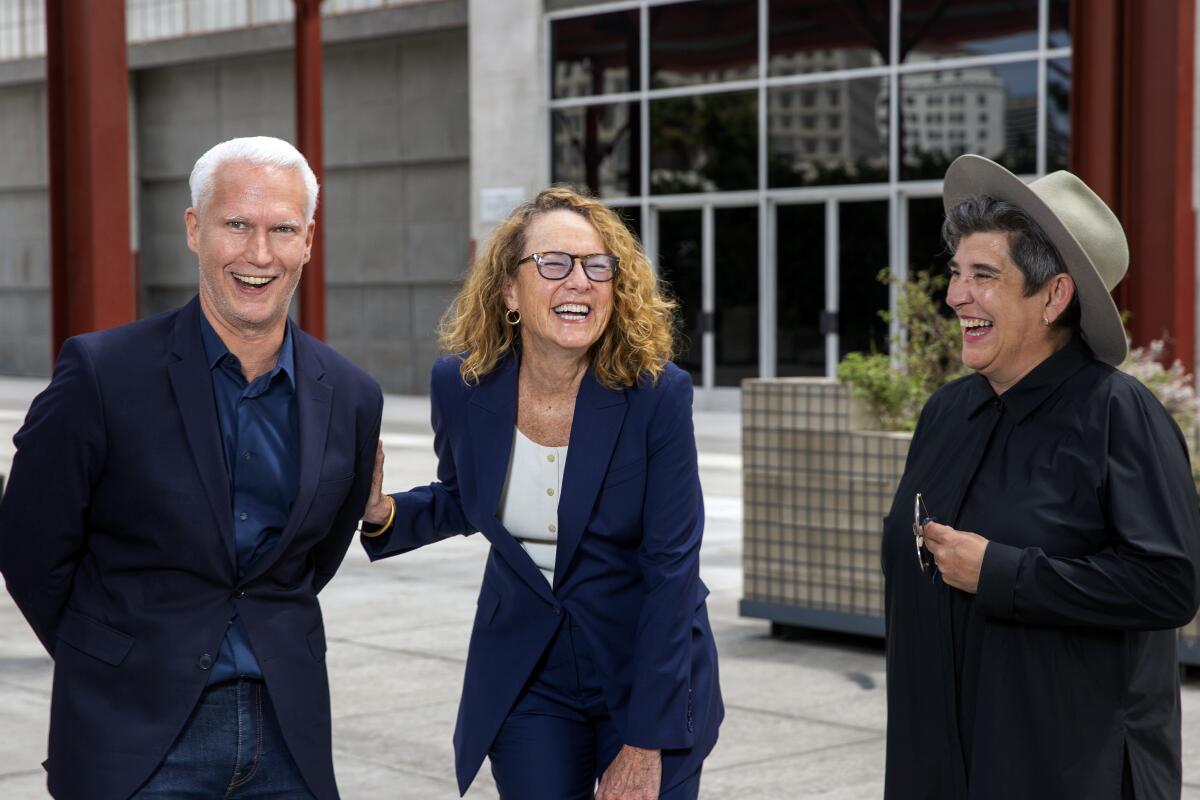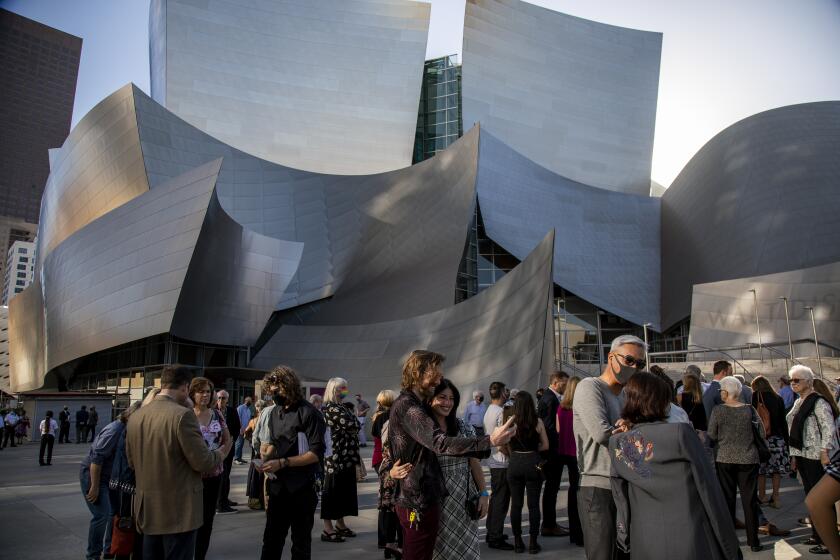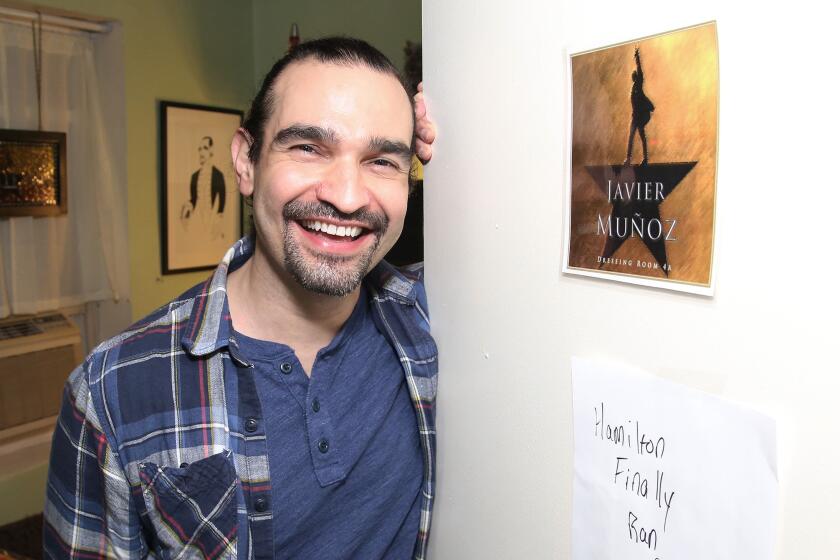Up to 20 tons of sand will be poured into an L.A. museum for fall’s biggest spectacle
- Share via
If autumn 2021 is anything like last year, hordes of Angelenos will flock to the beach in mid-October, seeking refuge from a heat wave. Some will trek north, to Malibu’s high bluffs and boulder-lined shores; others south, to the picturesque La Jolla seaside.
And some people will head downtown, to the Museum of Contemporary Art’s Geffen Contemporary.
“Sun & Sea,” the climate-crisis opera that earned the top prize at the 2019 Venice Biennale, will make its West Coast premiere at the Geffen Contemporary on Oct. 14. The L.A. production — part contemporary opera, part crowdsourced performance art, part diorama come to life — is a joint presentation of MOCA, the Hammer Museum and the Center for the Art of Performance at UCLA. Directors of all three organizations — Klaus Biesenbach, Ann Philbin and Kristy Edmunds, respectively — joined forces to bring the work here as part of a U.S. tour.
The piece — directed by Rugilė Barzdžiukaitė, written by Vaiva Grainytė and scored by Lina Lapelytė, all Lithuanian women — addresses climate change in what could best be described as an operatic lament about the disintegration of our planet. Audience members will watch the performance from a U-shaped balcony, looking down onto a beach bathed in high noon sunlight — the Geffen Contemporary, transformed with 10 to 20 tons of locally sourced sand. Thirteen singers and eight non-singing performers, all part of the Lithuanian company Neon Realism, will relax on towels, slather on sunscreen, play badminton, nibble on snacks and build sandcastles as they perform the libretto, translated from Lithuanian into English. A live dog and several children fill out the crowd, and there’s plenty of ambient beach noise — chatter and laughter, the crinkling of food wrappers, a popping volleyball — layered over the recorded musical soundscape and live singing.
Soloists — playing societal archetypes such as a wealthy family, a retired couple, a single 20-something woman — wax anxiously poetic about the destruction of Australia’s Great Barrier Reef, the warming Earth and species extinction as well as global tourism’s effect on the planet. The result is a disquieting tension between the happy-go-lucky, voracious and profitable leisure industry and looming environmental catastrophe, conveyed with somewhat ironic levity by a panoply of swimsuit-clad characters in an otherwise merry setting.
“It’s sending a message that is so profound,” Philbin says. “But in the subtlest, most beautiful way that it’s disturbing.”
Yo-Yo Ma reprises his Bach marathon, the Ojai festival returns at long last and San Diego gathers at the new Rady Shell. Let the season begin.
The staging of the opera is particularly fluid, like the weather. The production is an hour long but repeats for a five-hour stretch without any pause, from 4 to 9 p.m., for three days. Audience members stay for just one presentation, but for the performers, it’s “endurance art,” as Biesenbach puts it — they don’t stop singing, even as the audience members swap out.
The performers can leave the beach-stage at any point during the five hours for a bathroom break or a snack, but when they return, they will be soaking wet — the implication being that they’ve taken a dip in the ocean. Meantime, audience members can wander around the balcony, viewing the production from different vantage points. A QR code will provide access to the program and lyrics.
The production is especially top-of-mind now, after the recent release of a U.N. report on climate change that was characterized as “a code red for humanity.”
“The company is very aware of the fires in California, the flooding and the hurricane spillover on the East Coast, heat waves in Arkansas,” Edmunds says. “It doesn’t change the lyrics, but it allowed them to feel knowledgeable about the things we’re facing.”
The audience’s vantage point — a bird’s-eye view — is critical.
“Looking down suggests you’re looking at the Earth,” Philbin says. “And it’s about the Earth.”
“You’re a witness but you’re in it also,” Biesenbach says.
“As if you are an animal, flying over,” Edmunds adds.
There’s a charged collegiality among the directors as they offer a tour of the soon-to-be-transformed Geffen. It’s partly due to their passion for the project — each saw different iterations of it in Italy or Lithuania but all were moved, they say — and partly because of the fast-paced, last-minute execution of the project. They partnered up only in May.

“Sun & Sea” debuted at the National Gallery of Art in Lithuania in 2017 before premiering at the Venice Biennale in 2019, where people waited in hours-long lines for performances. The production won the Golden Lion for best national presentation, generating yet more buzz. A European tour kicked off in March 2020 and is still underway.
Philbin had dreamed of bringing the opera to Los Angeles, but it’s an unconventional and complex production to stage, even in pre-pandemic times, and after COVID-19 hit, it didn’t seem realistic. Then she learned, in May, that the U.S. tour had a spot open.
She reached out to Edmunds, who runs a sister organization at UCLA, but the two soon realized they needed a large, flexible warehouse-like space with soaring ceilings. The Geffen was a natural fit.
“I was in New York, for Frieze [art fair],” Biesenbach says of getting Philbin’s call. “I was just screaming, in a taxi. But it was so joyful.”
“I didn’t even finish my sentence,” Philbin adds, “and he went: ‘I’m in!’”
The Hammer took on an administrative and fundraising role; CAP UCLA handled the logistics around live performance; and MOCA took on the transformation of the Geffen space.
The collaboration itself was very much in the spirit of the opera.
“The feeling, when you see it, is: We’re in this together,” Biesenbach says. “And this is the one thing — ecology — we have to work together on.”
The U.S. tour kicks off in mid-September at the Brooklyn Academy of Music before heading to Philadelphia’s Arcadia Exhibitions at Arcadia University as part of the city’s Fringe Festival in late September. It then goes to the Momentary, a satellite space of Crystal Bridges Museum of American Art in Bentonville, Ark., in early October before arriving in L.A.
In previous stagings of “Sun & Sea,” local volunteers from the public joined the cast on the beach. They didn’t sing; they simply added to the background activity, improv-style. The upcoming Brooklyn, Philadelphia and Arkansas stagings will include community participation.
In Los Angeles, the community participation role will be filled by 10 members from the choral ensemble Tonality.
“We felt that it was important — especially in COVID and especially after performance makers have had zero income for over a year — that the local folks we incorporate be artists that perform, can collaborate with this international company and that we cover the payment for them,” Edmunds says.
Los Angeles Philharmonic is the latest to require proof of full vaccination, with no exception based on personal or religious beliefs.
She helped cast Tonality — a “BIPOC-forward, social justice professional chorus of Angelenos,” as she describes it — for the opera, with an eye toward adding authenticity to the beach scene.
Different races, ages, body types, gender identities, sexual identities — “You’ll see a snapshot across the very diverse Los Angeles that we understand,” she says.
“Which wasn’t the case in Venice,” Philbin adds. “It reflected a more European crowd.”
The sand will come from an Irwindale quarry. Although sourcing and transporting it does have an environmental footprint, as do performers and other creatives traveling internationally on tour, the climate-minded production is thinking about sustainability. After the production ends, the sand will be given to local schools and playgrounds to replenish sandboxes.
Edmunds’ team will collect rocks, shells and driftwood to round out the Geffen beach, giving it a local feel.
Core costume and set design elements, however, are uniform city to city. The color palette of performers’ beachwear is a spectrum of pastels — rose, sage, light yellow — and there are no bright colors or logos on towels and umbrellas. The result is a muted, nostalgic feeling.
Under the harsh, faux-noon sunlight, performers’ exposed skin appears in ever-present danger of being sunburned, both a commentary on ozone depletion and UV exposure as well as a theatrical device adding an undercurrent of threat.
“The light is kind of brutal and makes you feel vulnerable,” Biesenbach says. “It doesn’t soothe — it feels like it hurts you.”
The soundscape — a recorded mix of electronic music and nature sounds along with the live singing — is a living “sonic sculpture,” Edmunds says. Sixteen speakers are tucked under the balcony scaffolding and elsewhere, so that the experience feels immersive.
The production overall is marked by “interdependence,” the directors say — among the three Los Angeles institutions, for one, and between tour organizers and local venues. Between performers — adults and children, humans and canines — and their participating audiences. Even within the notes of the opera itself.
“The opera isn’t standing arias of operatic frill,” Edmunds says. “It’s the singing voice that is continuously present throughout the community. Everyone in the cast steps forward when someone leaves. There’s an interdependence through the music.”
Ultimately, she adds, the artists behind “Sun & Sea” are “practicing a deep ethic of optimism” with the production.
“They wouldn’t make something dark or full of lamentation or provocation that is emotionally difficult,” she says, “if it didn’t also create something cathartic.”
Laura Osnes’ exit from a show because of COVID-19 vaccination rules divides Twitter, but critic Charles McNulty says there should be no debate. Just get vaccinated.
More to Read
The biggest entertainment stories
Get our big stories about Hollywood, film, television, music, arts, culture and more right in your inbox as soon as they publish.
You may occasionally receive promotional content from the Los Angeles Times.













